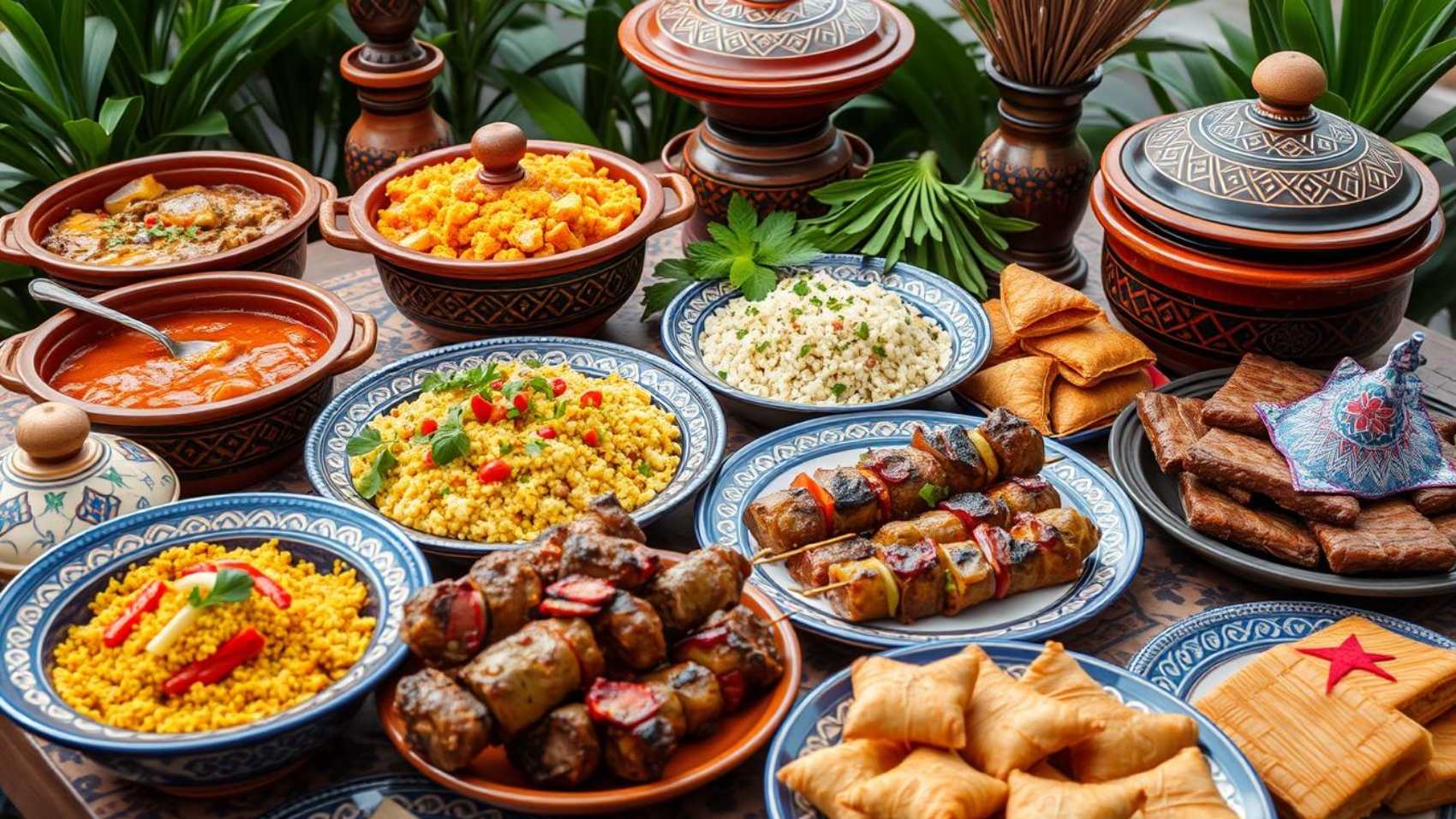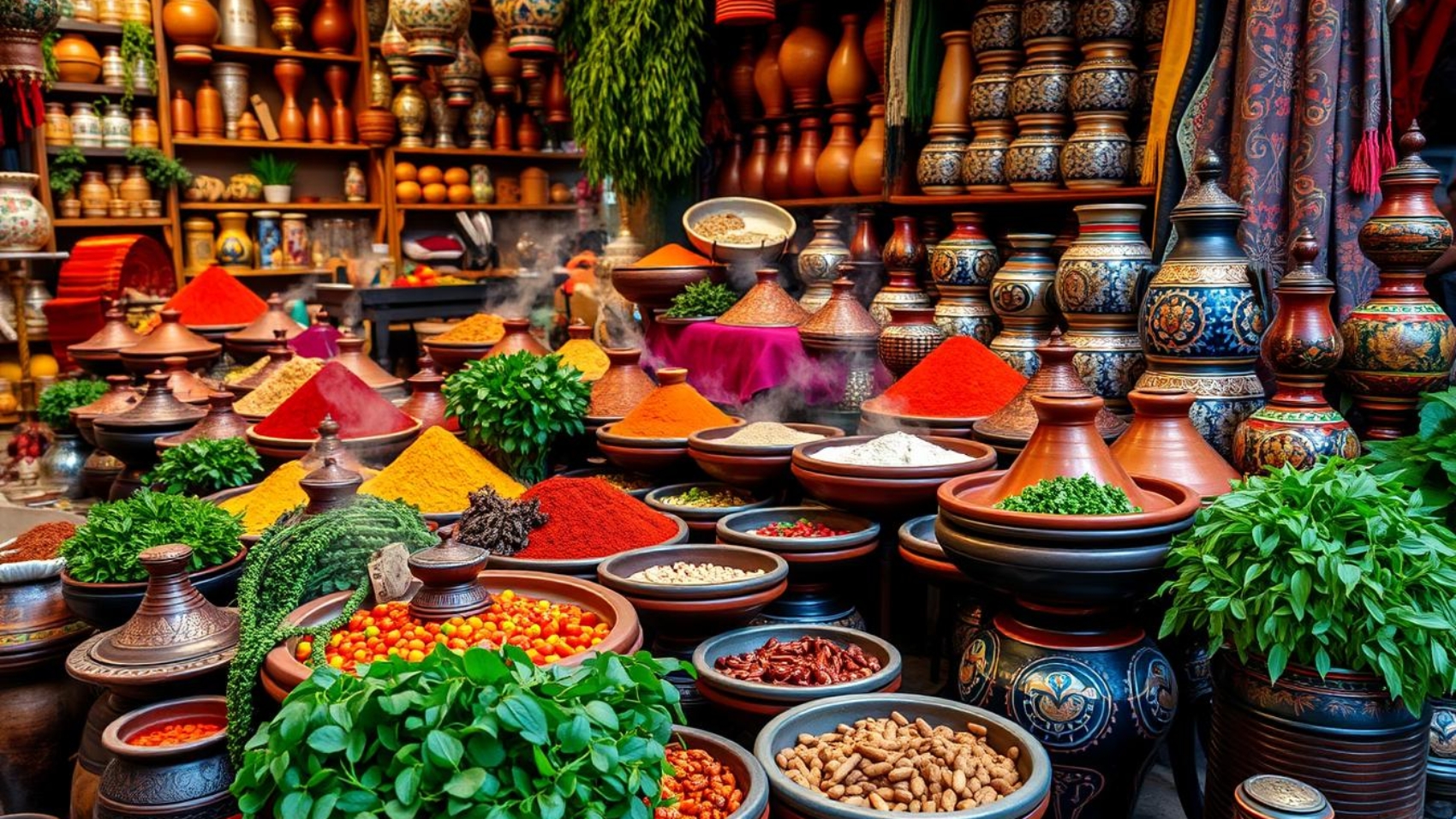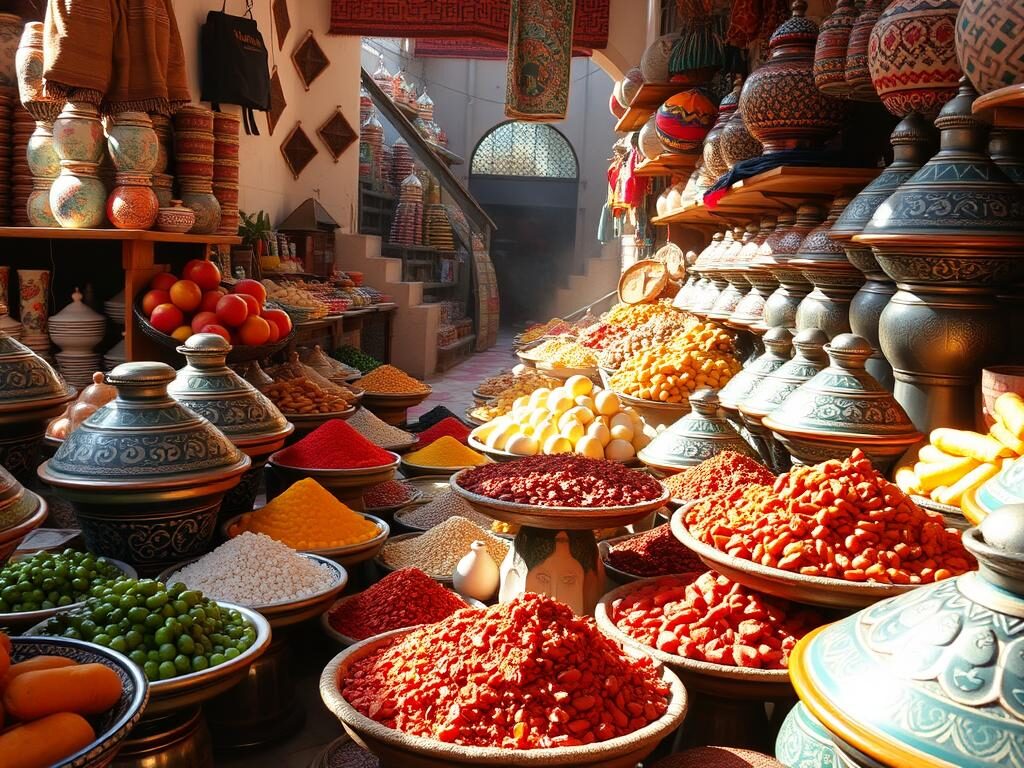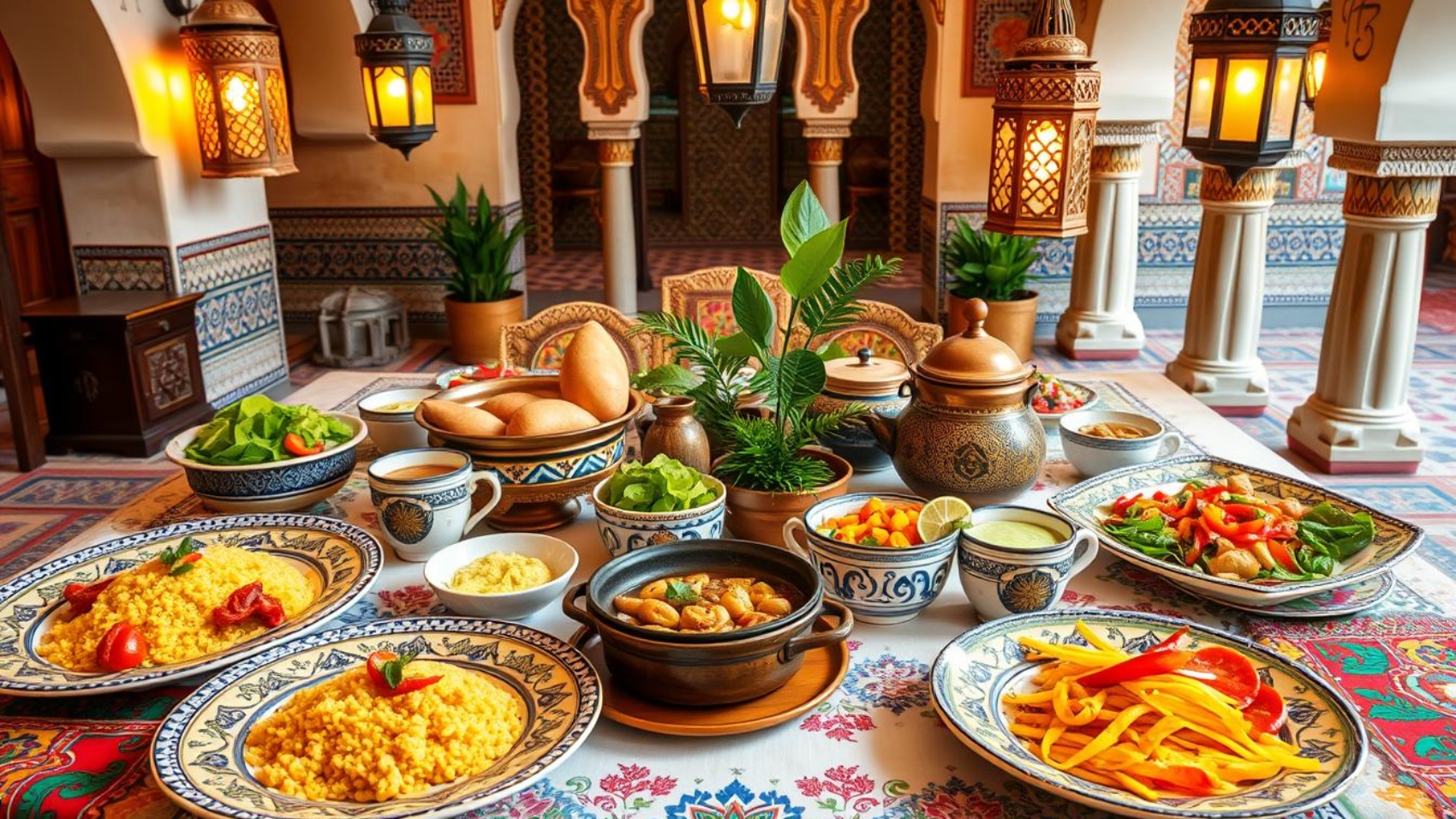Welcome to the vibrant world of Moroccan food. It’s a culinary adventure that grabs your senses. Moroccan cuisine is known for its bold flavors, intricate spice blends, and unique cooking techniques.
With a rich history, Moroccan recipes mix North African ingredients and cooking methods. As we dive into this cuisine, we’ll see why it’s loved by food lovers worldwide.
Introduction to Moroccan Cuisine
Moroccan cuisine is a vibrant mix of flavors, shaped by centuries of cultural exchange. It focuses on fresh ingredients and aromatic spices. This creates a unique taste experience that shows the country’s rich heritage.
The flavors come from Berber, Arab, and Mediterranean traditions. This blend of spices and cooking methods makes Moroccan food both savory and sweet. It often surprises the taste buds with new combinations.
Dining in Morocco is more than just eating. It’s about coming together as a community. Sharing a tagine or couscous brings families and friends closer. It highlights the cultural importance of meals, making every dish a story of tradition and togetherness.
The Rich History of Moroccan Food
The history of Moroccan food is a colorful mix of different influences. It shows the country’s rich cultural heritage. At the heart is the Berber culture, which started many traditional cooking ways.
Grains, legumes, and lots of herbs and spices show the Berbers’ deep bond with the land. This bond is still seen in how they cook today. It shows a sustainable way of cooking that is still important.
The Influence of Berber Culture
Knowing about the Berber impact on Moroccan food is key. The Berbers grew many crops, shaping how food was made. They used:
- Couscous
- Chickpeas
- Fresh vegetables and herbs
These ingredients give Moroccan food its unique taste. Cooking methods like slow-cooking and steaming, seen in tagines, come from Berber traditions.
Arab and Mediterranean Influences
Arab traders and settlers brought new flavors to Moroccan food. They loved spices and bold tastes, changing local dishes. Spices like saffron, cumin, and cinnamon became key in Moroccan cooking.
Mediterranean influences also added to the mix. This created a blend of flavors that make up modern Moroccan cooking.
Key Ingredients in Traditional Moroccan Dishes
Exploring traditional Moroccan recipes reveals a world of flavors. Local markets overflow with fresh produce. Meats and grains form the base of many dishes. These moroccan ingredients create a unique taste that reflects the region’s culture.
Common Vegetables and Fruits
Moroccan dishes feature a mix of vegetables and fruits. You’ll find:
- Tomatoes
- Eggplants
- Carrots
- Oranges
- Olives
These add freshness and a tangy touch, boosting the taste of many dishes.
Meats and Proteins in Moroccan Cooking
Meats are key in Moroccan cooking. Lamb, chicken, and seafood are favorites. They’re slow-cooked to blend flavors, making meals unforgettable.
Use of Grains in Moroccan Staples
Grains are deeply rooted in Moroccan culture. Couscous is a national dish, paired with meats and veggies. Bread, especially khobz, is vital for meals, used to scoop up stews and dips.
Understanding Moroccan Spices
Moroccan cuisine is a vibrant mix of aromatic spices. These spices are key to its unique taste. Each spice adds its own flavor, making Moroccan food unforgettable.
Essential Spices in Moroccan Recipes
Some of the most loved moroccan spices are:
- Cumin: It has a warm, earthy taste and is often used in spice blends.
- Coriander: This spice adds a citrusy flavor, making dishes brighter and more enjoyable.
- Saffron: Known as the most expensive spice, saffron gives a floral taste and a golden color.
- Ras el Hanout: A mix of spices, Ras el Hanout can have up to twenty spices. It’s a key spice in Moroccan cooking.
How Spices Enhance Moroccan Flavors
Using these spices turns simple foods into amazing dishes. The right mix of spices adds depth and richness. Plus, many spices are good for you, like cumin and coriander.
Learning to blend spices lets home cooks bring out the best in Moroccan food. It makes their dishes even more delicious.
Popular Moroccan Dishes to Try
Exploring Moroccan cuisine is a treat for the taste buds. You’ll find dishes like couscous, tagine, and pastilla. Each dish gives a peek into Morocco’s rich culinary history.
Couscous: The National Dish
Couscous is a key part of Moroccan food, seen as the national dish. It’s made from steamed semolina grains. These grains are topped with vegetables, meats, and rich sauces.
Every region has its own twist on couscous. Spices and local ingredients make each dish unique. This shows the diversity and tradition in Moroccan cooking.
Tagine: A Culinary Icon
Tagine is more than a dish; it’s a cooking method that shows Moroccan culinary skill. It’s cooked in a clay pot, allowing flavors to blend slowly. Chicken or lamb with vegetables and spices are common ingredients.
Tagine is meant to be shared with family and friends. It brings people together, making it a favorite in many homes.
Pastilla: A Sweet and Savory Delight
Pastilla is a dish that combines sweet and savory flavors in a flaky pastry. It’s traditionally made with pigeon or chicken. Spices like cinnamon and powdered sugar add to its unique taste.
There are many variations of pastilla. Some use seafood or offer vegetarian options. This shows the creativity and flexibility in Moroccan cooking.
Moroccan Cooking Techniques
Moroccan cooking techniques are key to unlocking the rich flavors and aromas of this cuisine. Tagines are a standout method, allowing for slow cooking. This method lets ingredients simmer together, making each bite full of flavor.
The Art of Slow Cooking in Tagines
Tagines offer a unique cooking experience. Their conical lids circulate steam, keeping food moist and tender. Spices and herbs blend with meats and veggies, turning simple ingredients into delicious meals.
Dishes like lamb tagine with apricots and chicken tagine with preserved lemons show the magic of this method. They transform ingredients into exquisite dishes.
Grilling and Spit-Roasting
Grilling and spit-roasting are also big in Moroccan cooking. They’re used for meats, adding a smoky flavor. Whole chickens or lamb skewers get a perfect char on the outside while staying juicy inside.
This cooking style is not just efficient. It also brings people together, making meals a communal affair.
Moroccan Food and Cultural Experiences
Moroccan cuisine is a key part of the nation’s culture. It shows the rich traditions and community bonds. Food plays a big role in family gatherings and social events, showing its importance.
Sharing meals with loved ones is a big part of Moroccan culture. It shows that food is more than just food. It brings families and friends closer together.
Family Gatherings and Festive Meals
At special times like weddings and Eid, families come together for big meals. These meals are filled with traditional dishes that hold deep meanings. Some common dishes include:
- Couscous, served on Fridays, is a sign of good fortune.
- Tagine, a slow-cooked dish, shows the community’s effort.
- Sweet pastries bring joy and show hospitality.
These traditions make food a key part of bonding during important life events.
The Role of Food in Social Events
In Moroccan culture, food is key to socializing. Sitting down to a table with many dishes sparks conversations and connections. Whether it’s a casual get-together or a formal dinner, sharing a meal strengthens bonds.
Customs like serving guests with ceremony show Morocco’s deep hospitality. This welcoming spirit not only builds relationships but also makes experiences memorable.
Finding the Best Moroccan Restaurants
Exploring the best Moroccan restaurants can make your dining experience unforgettable. You’ll get to taste authentic flavors that truly represent the culture. This guide will help you find top spots for Moroccan cuisine.
By visiting these places, you’ll dive into the world of authentic Moroccan food. You’ll enjoy vibrant atmospheres and traditional decor.
Top-Rated Restaurants to Experience Moroccan Food
Many restaurants are known for their amazing food and service. Here are some top choices for Moroccan dining:
- Restaurant Name A: Famous for its delicious tagines and friendly service.
- Restaurant Name B: Provides a unique setting with live music and traditional dishes.
- Restaurant Name C: Uses local ingredients and focuses on authentic flavors.
How to Choose Authentic Moroccan Dining
Finding authentic Moroccan dining can make your meal even better. Here are some tips to find the best Moroccan restaurants:
- Look for menus with traditional dishes like couscous and pastilla.
- Check if they use traditional cooking methods, like tagines and slow-roasting.
- Read reviews on restaurant review sites and food blogs for genuine Moroccan experiences.
Easy Moroccan Recipes for Home Cooks
Home cooks can enjoy Moroccan cuisine with easy recipes. These recipes use simple ingredients and methods. They’re perfect for beginners who want to try traditional Moroccan dishes at home.
Simple Recipes to Get Started
Start your culinary journey with these delightful recipes:
- Couscous Salad: A light mix of fluffy couscous, diced vegetables, and zesty lemon dressing.
- Chicken Tagine: A basic tagine recipe featuring chicken, olives, and preserved lemons.
- Lentil Soup: A hearty soup made with lentils, tomatoes, and a blend of spices.
Tips for Cooking Moroccan Food at Home
Here are some tips for cooking Moroccan food at home:
- Source fresh spices and herbs for authentic flavors.
- Experiment with ingredient substitutions based on availability.
- Utilize online cookbooks and blogs to find inspiration and detailed recipes.
Exploring Moroccan Cuisine Beyond Borders
Moroccan cuisine has become a hit worldwide, winning hearts with its unique flavors and vibrant colors. Dishes like couscous, tagine, and pastilla are now found in restaurants and homes everywhere. This shows how people are getting more interested in trying different foods.
International Trends in Moroccan Dining
As Moroccan food becomes more popular, chefs are mixing its flavors with other cuisines. This creates new and exciting dishes. Some trends include:
- Street Food Adaptations: Moroccan-inspired street food is now trendy, thanks to food trucks and casual spots.
- Gourmet Takes: Fancy restaurants are offering fancy versions of Moroccan classics, making dining a special experience.
- Plant-Based Variations: More vegetarian and vegan options are popping up, showing how versatile Moroccan ingredients can be.
Popular Moroccan Dishes Worldwide
Some Moroccan dishes have become favorites around the globe. They inspire people to try making them at home. Here are a few favorites:
- Couscous: This dish is loved for its fluffy texture and the many toppings you can add.
- Tagine: Known for its slow-cooked flavors, it comes in many variations to suit everyone’s taste.
- Pastilla: This dish is a mix of sweet and savory, and it always impresses diners.
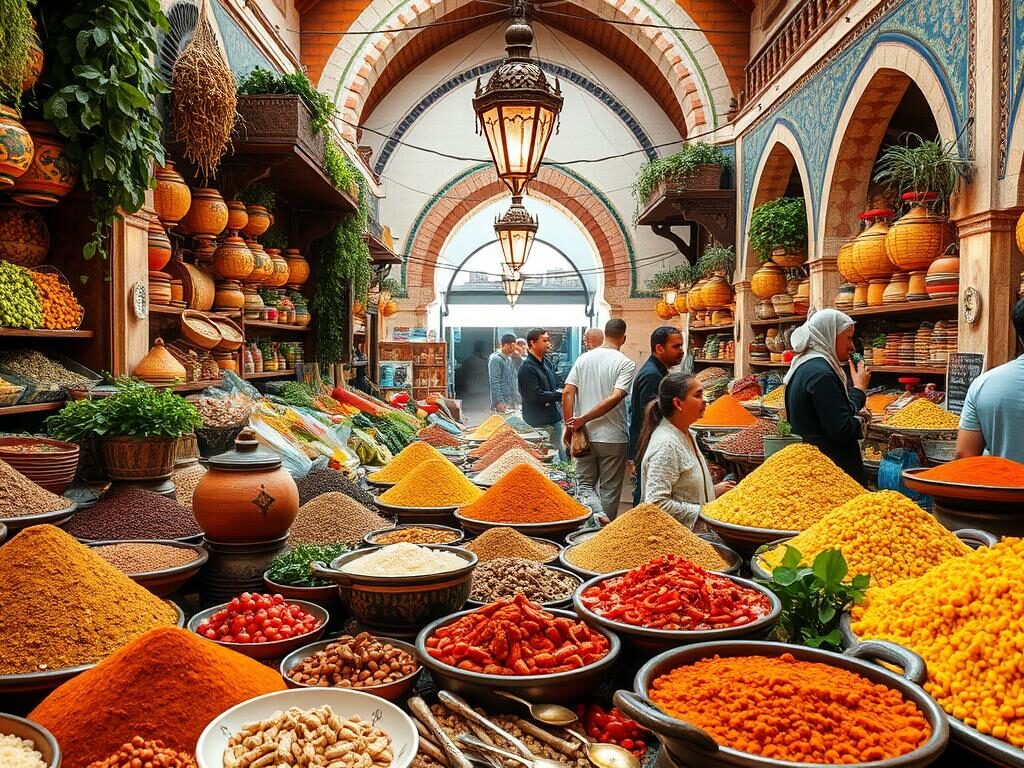
Conclusion
Moroccan cuisine is a treasure trove of flavors, with a rich history and vibrant ingredients. Each dish has a story, blending Berber roots with Arabian traditions. Moroccan dishes like tagine and couscous are more than just food; they’re about community and celebration.
Exploring Moroccan food introduces you to beneficial spices and nutritious ingredients. These can improve your health and well-being. Cooking and sharing these meals strengthens family and friend bonds, making every gathering special.
Starting your culinary journey with Moroccan cuisine is easy and rewarding. You’ll enjoy every savory bite, whether dining out or cooking at home. Moroccan food will surely delight your taste buds and enhance your cooking experiences.
FAQ
What are some traditional Moroccan dishes I should try?
Traditional Moroccan dishes include Couscous, the national dish. Tagine, a slow-cooked stew, is another classic. Pastilla, a sweet and savory pastry, is also a must-try. These dishes highlight the rich flavors and unique spices of Moroccan food.
What makes Moroccan cuisine unique?
Moroccan cuisine stands out for its diverse spices like cumin, coriander, and saffron. The mix of Berber, Arab, and Mediterranean influences creates a unique taste. The focus on communal meals and cooking in tagines adds to its cultural richness.
How do I find the best Moroccan restaurants?
Look for Moroccan restaurants that focus on authentic food and traditional cooking. Check reviews on food blogs and seek local critics’ recommendations. Popular spots serve classic dishes like tagine and couscous in a welcoming setting.
Can I make Moroccan food at home? Are there easy recipes available?
Yes, you can make Moroccan food at home. Simple dishes like couscous salad or basic tagine are easy to make. Many blogs and cookbooks offer step-by-step guides to help beginners.
What herbs and spices should I stock for cooking Moroccan food?
Key spices include cumin, cinnamon, ginger, paprika, and Ras el Hanout. Herbs like cilantro and parsley are also used. Having these spices will help you make a variety of delicious Moroccan dishes.
What are some common cooking techniques used in Moroccan cuisine?
Moroccan cooking often involves slow cooking in tagines to keep flavors and moisture. Grilling and spit-roasting meats are also traditional. Knowing these techniques can improve your Moroccan cooking.
How does Moroccan food reflect cultural traditions?
Moroccan food reflects cultural traditions through communal dining. Dishes like couscous or tagine are served in the center of the table. This encourages sharing and togetherness, highlighting the cultural importance of food in Moroccan hospitality.
Are there any health benefits associated with Moroccan ingredients?
Moroccan ingredients like legumes, vegetables, and spices have health benefits. Spices like turmeric have anti-inflammatory properties. Fresh vegetables add essential nutrients. Exploring traditional Moroccan recipes can lead to flavorful and healthy dishes.


